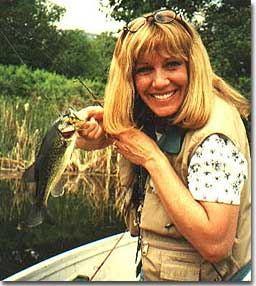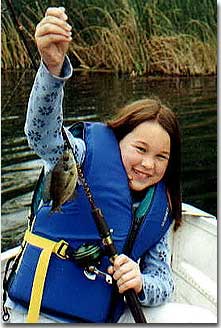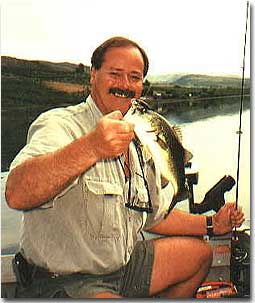Dry Lake Fishing a Delight For the Hard-Core to Kids
Dry Lake Fishing a Delight For the Hard-Core to Kids
Of course you can’t tell by reading this, but I ‘m whispering. Whispering because I’m about to reveal one of the best kept secrets in spinyray fishing in North Central Washington. Whether you’re a tournament-class bass angler, or just someone who wants to take the kids out for an action-packed day, Dry Lake will fill the bill. I am confident that Dry Lake is pretty much a secret because everyone I’ve introduced to it—seasoned angler to novice—has remarked, “How come nobody’s here? The fishin’s great!”
 Eileen can't wait to get back to Dry Lake. You never know what is going to hit your Rapala next. Could be crappie, bluegill, or largemouth bass like this one.
Eileen can't wait to get back to Dry Lake. You never know what is going to hit your Rapala next. Could be crappie, bluegill, or largemouth bass like this one.
Dry Lake is a modest, 140-acre pond just over the hill from Manson at Lake Chelan. It’s probably not 20 feet deep at it’s deepest point and is lined with thick bunches of reeds. It doesn’t look like much and because there are two very popular lakes close by, it is largely ignored. Wapato Lake, a productive trout lake, is just up the hill from Dry Lake, and Roses, another great trout pond, is right next door.
It doesn’t look like much, but there is something about the way this little lake is put together that makes it a fish-producing factory. Largemouth bass thrive here. It is nothing to catch twenty or thirty juvenile largemouth weighing from a half-pound to a pound, in a day. It is possible for an experienced bass angler to get a fish or two weighing 3 to 4 pounds, and largemouth from 7 to 9 pounds have been taken here.
Crappies were very small when I first started fishing Dry Lake some nine years ago, but they are getting bigger. These guys would fit in my hand back then, but 11-inch fish are common now. They aren’t as common as the bass in the lake, but when you hit a pocket of them, hang on!
 Even small fish bring big grins to small girls. Dry Lake is great for kids. The fast action keeps them busy!
Even small fish bring big grins to small girls. Dry Lake is great for kids. The fast action keeps them busy!
Bluegill are the most heavily populated species in the lake, and I mean there are gobs of them. They are hiding out under every bush and reed. They are packed around the off shore weeds. They are everywhere. It is not unusual at all to make a cast and have the water spray from scattering schools of bluegill that have been sunning themselves just a few feet from your boat. The bluegill have also gained dimension since I started fishing Dry Lake. Now you can expect to catch a fair number that will span from your watchband to the tip of your fingers. These are great fun on ultra-light spin gear or a fly rod.
Just to give you an idea of just how many bluegill are around, here’s a story. I was fishing the lake by myself once, and since I had always told people that I caught a ton of fish here, I decided to actually count them. I was using a fly rod and flipping a Helgramite toward the reeds. By the time I had worked about three hundred yards of shore I quit counting. You see I had already caught a hundred bluegill by then and I just didn’t want to keep counting anymore. That was plenty!
There are perch in Dry Lake, too, and their numbers and size are also growing. I don’t remember catching any perch five or six years ago, but now I get a couple every trip without even trying for them. Most of them are around nine inches, but last season I got one that was a solid eleven incher on a Rapala.
There are even catfish or bullheads in the lake. I spent and evening with some friends soaking worms at the south end, and we caught a mess of them. They will weigh up to a pound or better, but few people bother with them.
So, that’s a thumbnail of what’s in the lake, but I’m sure you’d like to hear something on how to catch them. I’ll be happy to share what I’ve learned, to make for a successful day on Dry Lake.
Let’s start with the bass.
I’ve thrown spinner baits. I’ve flipped worms. But the one sure-fire lure I’ve found that gets largemouth to attack at Dry Lake is a black-back, white-bellied floating Rapala. A number 5 or 7 will work just fine, and because I’m pretty casual about it I am usually using six- to eight-pound test line. I have caught enough largemouth trolling this plug to sink a small boat, but of course the best way to go about it is casting to the reeds along the shore.
As with most reed-lined shores, there are all kinds of pockets, breaks, and miniature bays here at Dry Lake. This is where I like to toss that plug. Even the smallest little hole in the reeds can produce a big surprise. I have to retrieve my lure from the brush occasionally, but it’s worth an errant cast once in a while to put the lure practically on the bank. Sometimes the bass pounce as soon as the plug hits the water. Sometimes you have to let it sit until the rings on the water have disappeared before you give the lure a little twitch. Other times I can just chuck and crank. You have to experiment with your retrieve until you find out what mood the bass are in. Don’t give up on your retrieve too early either. Sometimes they will chase it out to the boat and hit about when you are about to lift the lure out of the water.
I never go to Dry Lake without my Rapalas, but I’m not saying that other lures aren’t effective. This is just the most consistent bass-getter for me. I have also taken bass to 4 pounds and better on six-inch salted worms, fished with a split shot about four feet above it. I have had fish take this so close to the boat that I have watched them open their mouths to inhale it. One of the best fish I’ve taken on Dry Lake swallowed a black Power Worm that I pinched in half. I was fishing it without any weight cause I was casting into such a mess of weeds I didn’t want to have to peel them off when they caught on my split shot.
Dry Lake is actually a great place to experiment with tackle. There are plenty of bass here that will take a look at just about anything you’re willing to throw.
 Ultra light tackle makes catching largemouth bass like this one a blast!
Ultra light tackle makes catching largemouth bass like this one a blast!
Another reason I like the Rapala is that if the bass don’t get it, the bluegill or crappie will! One of the ways I prospect for crappie is by trolling the Rapala. I will be catching bass and bluegill right along, and then here comes a crappie. When that happens it’s time to stop the boat and switch to jigs or flies.
Sure, I could just troll back and forth over the spot and continue to catch crappie, but they are fairly concentrated in certain spots on Dry Lake. When you find them, you can really work the school by marking your location or even anchoring.
Jigs and bobbers or jigs without a bobber are what I will switch to when I land on a bunch of crappie. Be sure to have a selection of colors, and 1/32- to 1/16-ounce is good enough. Over time I have come to prefer the black-and-chartreuse color, and it’s always the one to start with. You can always tip the hook with a worm, but more often than not, it isn’t necessary at Dry Lake.
The bobber and jig set up can also be fished along the shoreline and in the weed beds. There are a couple of small trees next to the water on the south shore of the lake, and a cast under their branches is a sure thing.
If I make fishing at Dry Lake sound simple it’s because it is. I’m not saying that there can’t be bad days. Hey, that’s fishing. But bad days are pretty darn rare on Dry Lake. I do remember hitting the lake once in early April and I couldn’t find a fish. It was spooky. I thought that it had winter killed or something. I went back two weeks later and it was alive with fish. I just got there too early that season.
If Dry Lake sounds like it would be worth a trip, I’ll tell you how to get there. When you get to Chelan, take the north shore road to Mill Bay Casino, which is just across the road from the Mill Bay boat launch on the big lake. Follow this road until you get to Roses Road. Take a left and follow this to Green Avenue. You will first see Roses Lake, but keep going about a quarter mile and you’ll hit Dry Lake.
There are two rough launches on Dry Lake, and they are well used because shore access is very limited here. Even a small inflatable raft will get you to the fishing grounds, but I’ve seen the big bass boats here, too. One launch is on the south shore about a quarter of the way up the lake. It’s just a hole through the trees, but it works. The other is on the north shore near the bottom end of the lake, and it’s pretty steep. It would be wise to have four-wheel to use this one.
It doesn’t really matter how you get out on the water at Dry Lake. Float tube, raft, or fancy bass boat. Getting on the water here is pretty much a guaranteed good time. I sometimes regret taking Eileen, the love of my life and “native guide” to Dry Lake. There’s no excuse for not getting off the couch and going fishing now. She knows we can always have a great day at Dry Lake.
Dave Graybill
|